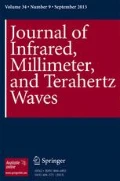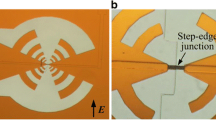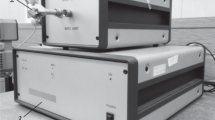Abstract
Solid-state sources consisting of cascaded Schottky diode-based frequency multipliers are commonly used to generate power at millimeter and submillimeter wave bands. In order to achieve increasing power at those frequencies, first-stage frequency multipliers have to handle a large amount of input power and generate enough output power to drive higher frequency multiplication stages. To that end, an appropriate electro-thermal design of multiplier circuits can result in improvement of power-handling capabilities without degradation of conversion efficiency. This work proposes an approach for the design of frequency multipliers where both electrical and thermal considerations are self-consistently taken into account along the optimization of the Schottky diode structure and the circuit layout. The proposed methodology is validated with the design and test of a split-block waveguide single-chip tripler circuit with output frequency in the 225–325-GHz band. Good agreement between predicted performance and measured results is obtained for a wide input power range and different ambient temperatures.










Similar content being viewed by others
Change history
22 September 2022
A Correction to this paper has been published: https://doi.org/10.1007/s10762-021-00782-x
Notes
High Frequency Structure Simulator (HFSS), ANSYS, Inc., Canonsburg, PA, USA
MPHYSICS STUDIO (MPS), CST - Computer Simulation Technology GmbH, Darmstadt, Germany
Advanced Design System (ADS), Keysight Technologies, Inc., Santa Rosa, CA, USA
Keysight Technologies, Inc., Santa Rosa, CA, USA
OML, Inc., Morgan Hill, CA, USA
Farran Technology Ltd., Cork, Ireland
QuinStar Technology, Inc., Torrance, CA, USA
Radiometer Physics GmbH, Meckenheim, Germany
Virginia Diodes, Inc., Charlottesville, VA, USA
Vötsch Industrietechnik GmbH, Balingen, Germany
References
T.W. Crowe, W.L. Bishop, D.W. Porterfield, J.L. Hesler, R.M. Weikle, IEEE J. Solid-State Circuits 40(10), 2104 (2005).
G. Chattopadhyay, IEEE Trans. THz Sci. Technol. 1(1), 33 (2011).
I. Mehdi, J.V. Siles, C. Lee, E. Schlecht, Proc. IEEE 105(6), 990 (2017).
C. Lee, J. Ward, R. Lin, E. Schlecht, G. Chattopadhyay, J. Gill, B. Thomas, A. Maestrini, I. Mehdi, P. Siegel, in IEEE MTT-S Int. Microw. Symp. Dig. (2009), pp. 957–960.
D. Porterfield, T. Crowe, W. Bishop, D. Kurtz, E. Grossman, in The Joint 30th Int. Conf. Infrared and Milli. Waves and 13th Int. Terahz. Electron. Conf. (2005), pp. 78–79.
A. Maestrini, J. Ward, C. Tripon-Canseliet, J. Gill, C. Lee, H. Javadi, G. Chattopadhyay, I. Mehdi, IEEE Microw. Wireless Compon. Lett. 18(3), 218 (2008).
J.V. Siles, A. Maestrini, B. Alderman, S. Davies, H. Wang, J. Treuttel, E. Leclerc, T. Narhi, C. Goldstein, IEEE Microw. Wireless Compon. Lett. 21(6), 332 (2011).
J.V. Siles, C. Lee, R. Lin, G. Chattopadhyay, T. Reck, C. Jung-Kubiak, I. Mehdi, K.B. Cooper, IEEE Microw. Wireless Compon. Lett. 25(3), 157 (2015).
J.S. Ward, G. Chattopadhyay, J. Gill, H. Javadi, C. Lee, R. Lin, A. Maestrini, F. Maiwald, I. Mehdi, E. Schlecht, P. Siegel, in Proc. 33rd Int. Conf. Infrared Milli. and Terahz. Waves (2008), pp. 1–3.
A.Y. Tang, E. Schlecht, G. Chattopadhyay, R. Lin, C. Lee, J. Gill, I. Mehdi, J. Stake, in Proc. 22nd Int. Space THz Technol. Symp. (2011).
D. Moro-Melgar, O. Cojocari, I. Oprea, in Proc. 48th European Microw. Conf. (2018), pp. 1357–1360.
A.Y. Tang, E. Schlecht, R. Lin, G. Chattopadhyay, C. Lee, J. Gill, I. Mehdi, J. Stake, IEEE Trans. THz Sci. Technol. 2(3), 290 (2012).
J.V. Siles, C. Lee, R. Lin, E. Schlecht, G. Chattopadhyay, I. Mehdi, in Proc. 39th Int. Conf. Infrared Milli. and Terahz. Waves (2014), pp. 1–3.
N. Alijabbari, M.F. Bauwens, R.M. Weikle, IEEE Trans. THz Sci. Technol. 4(6), 678 (2014).
T.W. Crowe, J.L. Hesler, S.A. Retzloff, D.S. Kurtz, in Proc. 42nd Int. Conf. Infrared Milli. and Terahz. Waves (2017), p. 1.
J.V. Siles, K.B. Cooper, C. Lee, R.H. Lin, G. Chattopadhyay, I. Mehdi, IEEE Trans. THz Sci. Technol. 8(6), 596 (2018).
C.G. Pérez-Moreno, J. Grajal, IEEE Trans. THz Sci. Technol. 4(5), 597 (2014).
T.K. Johansen, O. Rybalko, V. Zhurbenko, B. Bulcha, J. Hesler, Int. J. Microw. Wireless Technol. 10(2), 217 (2018).
J. Grajal, V. Krozer, E. González, F. Maldonado, J. Gismero, IEEE Trans. Microw. Theory Techn. 48(4), 700 (2000).
J.V. Siles, J. Grajal, IEEE Trans. Microw. Theory Techn. 58(7), 1933 (2010).
A. Maestrini, J. Ward, J. Gill, H. Javadi, E. Schlecht, C. Tripon-Canseliet, G. Chattopadhyay, I. Mehdi, IEEE Trans. Microw. Theory Techn. 53(9), 2835 (2005).
C.M. Snowden, IEEE Trans. Microw. Theory Techn. 45(1), 58 (1997).
G. Chattopadhyay, E. Schlecht, J. Ward, J. Gill, H. Javadi, F. Maiwald, I. Mehdi, IEEE Trans. Microw. Theory Techn. 52(5), 1538 (2004).
http://www.teratechcomponents.com. Accessed July 2019.
http://www.vadiodes.com. Accessed July 2019.
D.W. Porterfield, in IEEE MTT-S Int. Microw. Symp. Dig. (2007), pp. 337–340.
H. Wang, D. Pardo, M. Merritt, N. Brewster, P.G. Huggard, B. Alderman, in Proc. 8th UK, Europe, China Milli. Waves and THz Technol. Workshop (2015), pp. 1–3.
http://www.acst.de. Accessed July 2019.
http://www.farran.com. Accessed July 2019.
http://www.radiometer-physics.de. Accessed July 2019.
N. Alijabbari, M.F. Bauwens, R.M. Weikle II, IEEE Trans. THz Sci. Technol. 5(1), 73 (2015).
S. Khanal, T. Kiuru, A.Y. Tang, M.A. Saber, J. Mallat, J. Stake, T. Närhi, A.V. Räisänen, IEEE Trans. THz Sci. Technol. 4(2), 267 (2014).
S. Nadri, C.M. Moore, N.D. Sauber, L. Xie, M.E. Cyberey, J.T. Gaskins, A.W. Lichtenberger, N.S. Barker, P.E. Hopkins, M. Zebarjadi, R.M. Weikle II, IEEE Trans. Electron Devices 66(1), 349 (2019).
T. Kiuru, G. Chattopadhyay, T.J. Reck, A.J. Minnich, R. Lin, E. Schlecht, J.V. Siles, C. Lee, I. Mehdi, IEEE Trans. THz Sci. Technol. 6(2), 328 (2016).
F. Bonani, V. Camarchia, F. Cappelluti, S.D. Guerrieri, G. Ghione, M. Pirola, IEEE Microw. Mag. 9(5), 81 (2008).
P. Antognetti, G. Massobrio, Semiconductor device modeling with SPICE, 1st edn. (McGraw-Hill, 1988).
S.M. Sze, K.N. Kwok, Physics of semiconductor devices, 3rd edn. (Wiley, 2007).
V. Krozer, Simulation und Modellierung von THz-Schottky Dioden und Heterostruktur-Bipolar-Transistoren hergestellt auf Verbindungshalbleitern (Technische Hochschule Darmstadt, Darmstadt, Germany, 1997).
H.C. de Graaff, in NATO Advanced Study Institute on Process and Device Modeling for Integrated Circuit Design (1977), pp. 443–460.
H.C. Poon, H.K. Gummel, Proc. IEEE 57(12), 2181 (1969).
J.J.H. Van den Biesen, Phillips J. Res. 40, 88 (1985).
Acknowledgments
The authors would like to thank Teratech Components Ltd. for the fabrication, assembly, and preliminary test of the designed frequency tripler. In particular, the authors would like to thank Dr. Byron Alderman, Dr. Jeff Powell, and Dr. Colin Viegas for very helpful discussions along the design stage.
Funding
This work has been supported by the Spanish Ministry of Science, Innovation and Universities within the project TEC2017-87061-C3-1-R (CIENCIA/AEI/FEDER, UE) and by the Madrid Regional Government within the project S2013/ICE-3000 (SPADERADAR-CM).
Author information
Authors and Affiliations
Corresponding author
Additional information
Publisher’s Note
Springer Nature remains neutral with regard to jurisdictional claims in published maps and institutional affiliations.
Appendices
Appendix 1: Implementation Details of the Analytical Electro-Thermal Model
The analytical electro-thermal model presented in Section 2 and Fig. 2 is implemented into ADS using its Symbolically Defined Device (SDD) capability. The Schottky diode model incorporates a third terminal connecting the electrical and thermal networks and allowing self-consistent implementation of the temperature dependence of its parameters.
The junction temperature in each anode (\(T_{j_{i}}\)) is obtained from:
where Tamb is the ambient temperature and \({\Delta } T_{sh_{i}}\) represents the temperature increment in each anode due to self-heating and thermal coupling among anodes.
Following the topology of the thermal network in Fig. 2, \({\Delta } T_{sh_{i}}\) is related to the stationary dissipated power in each anode (\(P_{dis_{i}}\)) by a temperature-dependent thermal resistance matrix:
where N is the number of anodes. The elements \(R_{th_{ip}}(T_{j_{i}}, T_{amb})\) take into account the temperature increment in anode i produced by the stationary dissipated power in anode p when no power is dissipated in the rest of anodes [17]:
It must be remarked that for high excitation frequencies, temperature can be assumed to be time-independent since it is not able to follow variations of the instantaneous dissipated electrical power due to the fact that the thermal time constant is longer than the electrical time constant [35]. However, if thermal dynamics were desired to be taken into account, the thermal network should include instantaneous dissipated power sources and thermal capacitances, which together with thermal resistances define the thermal time constants (τth = Rth ⋅ Cth).
On the other hand, regarding the electrical parameters, the voltage-dependent and temperature-dependent junction current is calculated as [36]:
where Isat(Tj) is the temperature-dependent saturation current, Vj the junction voltage, n the ideality factor, k the Boltzmann constant, and q the elementary charge. The temperature-dependent saturation current is defined by [37]:
where A is the diode area, A∗∗ is the effective Richardson constant, and Φb is the barrier height. Denoting Isat(Tnom) as the saturation current at the nominal temperature (Tnom) at which the model parameters are extracted, the saturation current for a given Tj can be calculated as [36]:
In addition, the junction voltage is calculated as:
where Vd and Id are the diode voltage and current, respectively, and Rs(Tj) is the temperature-dependent series resistance, which is modeled with the following expression [38]:
where Rs(Tnom) is the series resistance at Tnom and β(T) for GaAs is [38]:
Isat(Tnom), n, and Rs(Tnom) are obtained from physics-based numerical simulations. The temperature dependence of n and Φb is not considered at present.
Appendix 2: Model for the Calculation of Junction Capacitance
The voltage-dependent junction capacitance is determined by:
where Qj(Vj) is the voltage-dependent junction charge.
Our analytical model includes a sophisticated capacitance model proposed by de Graaff [39], which avoids the singularity given by the theoretical model for fully depleted semiconductor regions when Vj approaches the built-in voltage Vbi [36] and includes the capacitance decrease predicted by physics-based models. It is a modification of the Poon and Gummel’s model [40] that results in a more accurate capacitance description at forward conditions [41]:
where Cj0 is the junction capacitance at zero bias (Vj = 0) and is obtained from physics-based numerical simulations, m is the junction grading coefficient (m = 0.5 for abrupt junctions), and u and δ are:
where Cmax is an adjusting parameter which allows obtaining the proper maximum capacitance value.
It can be remarked that, for a consistent SDD implementation into ADS, this model has to be defined in terms of a voltage-dependent charge function Qj(Vj) by integrating the capacitance with respect to junction voltage.
Comparison of different capacitance models including the C-V characteristic simulated with our physics-based numerical model for the diodes used in the designed 225–325-GHz frequency tripler. The values of the parameters utilized in the de Graaff’s capacitance model incorporated into our analytical model are the following: Cj0 = 20.9 fF, Vbi = 0.83 V, m = 0.5, and Cmax = 160 fF. The vertical line represents Vbi
Finally, Fig. 11 shows a comparison of different capacitance models including the de Graaff’s model implemented in our analytical approach, the result given by our physics-based numerical model, and the SPICE model, which is the capacitance model included in the ADS diode model.
Rights and permissions
Springer Nature or its licensor holds exclusive rights to this article under a publishing agreement with the author(s) or other rightsholder(s); author self-archiving of the accepted manuscript version of this article is solely governed by the terms of such publishing agreement and applicable law.
About this article
Cite this article
Pérez-Moreno, C.G., Grajal, J. Self-Consistent Electro-Thermal Approach for Terahertz Frequency Multiplier Design. J Infrared Milli Terahz Waves 41, 1508–1529 (2020). https://doi.org/10.1007/s10762-020-00747-6
Received:
Accepted:
Published:
Issue Date:
DOI: https://doi.org/10.1007/s10762-020-00747-6





